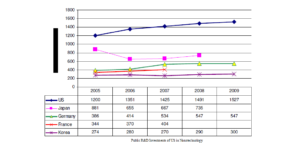Nanotechnology Assignment Help
Nanotechnology is the first key global research initiative of the 21st century. In present, nanotechnologies are applied to different cross industrial problems and it is a broad purpose technology that works as both a foundation for  technology solutions or at the joining of other enabling technologies, such as biotechnologies, social psychology physical sciences, communication technologies, cognitive sciences, computational sciences, and other social sciences (Anton, Silberglitt & Schneider, 2001). Nanotechnologies are all-encompassing solution vectors in present economic environment. It is fundamental to extend new methods to evaluate nanotechnologies development and superior understanding nanotechnology based innovation (Tegart, 2004). As common purpose and empowering technologies, nanotechnologies disclose commercialization procedures, from start-ups to huge firms in association with public sector research, which in turn direct towards altering patterns of industrial organization which regulate public policy go-aheads to promote its development. Nanotechnology presents significant opportunities to create effective materials and products and this is the reason of its increasing use in US (Goldman & Coussens, 2005). Here, in this assignment help paper nanotechnology’s influence on culture within the United States and outside of the United States and media within the United States and outside of the United States is discussed to identify the growth of nanotechnology in US and outside of the US.
technology solutions or at the joining of other enabling technologies, such as biotechnologies, social psychology physical sciences, communication technologies, cognitive sciences, computational sciences, and other social sciences (Anton, Silberglitt & Schneider, 2001). Nanotechnologies are all-encompassing solution vectors in present economic environment. It is fundamental to extend new methods to evaluate nanotechnologies development and superior understanding nanotechnology based innovation (Tegart, 2004). As common purpose and empowering technologies, nanotechnologies disclose commercialization procedures, from start-ups to huge firms in association with public sector research, which in turn direct towards altering patterns of industrial organization which regulate public policy go-aheads to promote its development. Nanotechnology presents significant opportunities to create effective materials and products and this is the reason of its increasing use in US (Goldman & Coussens, 2005). Here, in this assignment help paper nanotechnology’s influence on culture within the United States and outside of the United States and media within the United States and outside of the United States is discussed to identify the growth of nanotechnology in US and outside of the US.
Nanotechnology Influence on Culture within the US and outside of the US With increasing attention towards the use of nanotechnology in US and other countries like Japan, Germany, Europe etc in different fields, it can be said that nanotechnology significantly influence the culture within the US and outside of the US. The culture here refers to doing business through the means of energy efficient technologies that are effective and environmentally sound. With evolution of nanotechnology from 1980s, it has significantly influence the culture within the US as well as outside the US and this is the reason of its increasing use in present (Anton, Silberglitt & Schneider, 2001). Today’s world where everyone is concerned regarding climate change, pollution, water shortages, resource depletion etc. nanotechnology is considered as a new environmental saviour. Nanotechnology is been focussed by both the public and private enterprises throughout the globe (Poole & Owens, 2003). Influence on nanotechnology on the culture within the US could also be understood with the evolution of nanotechnology policies and programs in the United States. Today, Federal R&D policy in nanotechnology has moved from different stages that were not possible without the supportive culture for nanotechnology and its positive influences on societal development. The country government early exploration before the 1980s, the encouragement of scientific and technological discoveries in the 1980s, policy expansion in the 1990s and multi-agency national initiatives in the 2000s depict how nanotechnology have influenced the culture within the US (Ramsden, 2005). Since 2001, the key federal R&D policy mechanism in nanotechnology in the US has been the National Nanotechnology initiative that assists in promoting investment in nanotechnology and its use in different fields (Kessler & Charles, 2007). Today as per university assignment writing experts of US and Australia, US are among one the three states (US, Japan, and Germany) that dominate the present R&D effort in the nanotechnology. The country enjoys highest public shares in R&D investment as depicted in Figure 1. The US is among one the top investors in nanotechnology R&D as here government significantly supports nanotechnology fundamental research, infrastructure advancement, and technology transfer reflecting the potential of nanotechnology R&D in encouraging capabilities and contributing to national priorities (Review of international nanotechnology developments and policy concerns, 2009). On the other hand, outside the US, Japan and Germany also dominate the present R&D efforts regarding nanotechnology. Recently Korea has also evolved as a key player in the worldwide nanotechnology space and this has become possible only due to the positive influence of nanotechnology on country culture related to doing business and sustaining the society in long run (Kessler & Charles, 2007).
Public R&D Investments of US in Nanotechnology
 (Source: Review of international nanotechnology developments and policy concerns, 2009). With an evaluation of the structure of nanotechnology R&D investment by regions, it becomes clear that there is significant difference between the influence of nanotechnology on culture within the US and outside the US. Highest private shares in R&D investment related to nanotechnology is in the US and Japan in comparison to the EU and other regions (Mangematin & Walsh, 2012). In US, nanotechnology research spectrum used is quite broad as it admits various research areas and has developed its power in amalgamation and assembly of nanoscale building blocks and accelerators, and in polymeric and biological approaches to non-structured materials (Anton, Silberglitt & Schneider, 2001). Already various, nonmaterial-containing products are available in U.S. markets involving computers, coatings, cosmetics, clothing, sports equipment and medical devices but still research is continued to use it in several other fields. With increasing influence of nanotechnology in Japan, different research institutes and academic laboratories have set up in regard to attaining advancements in nano-devices and nano-instrumentation. The EU serves an assorted arrangement of campus research, webs, and nationwide laboratories with unique functioning in dispersion and coatings, nanobiotechnology, nanoprobes (Review of international nanotechnology developments and policy concerns, 2009).
(Source: Review of international nanotechnology developments and policy concerns, 2009). With an evaluation of the structure of nanotechnology R&D investment by regions, it becomes clear that there is significant difference between the influence of nanotechnology on culture within the US and outside the US. Highest private shares in R&D investment related to nanotechnology is in the US and Japan in comparison to the EU and other regions (Mangematin & Walsh, 2012). In US, nanotechnology research spectrum used is quite broad as it admits various research areas and has developed its power in amalgamation and assembly of nanoscale building blocks and accelerators, and in polymeric and biological approaches to non-structured materials (Anton, Silberglitt & Schneider, 2001). Already various, nonmaterial-containing products are available in U.S. markets involving computers, coatings, cosmetics, clothing, sports equipment and medical devices but still research is continued to use it in several other fields. With increasing influence of nanotechnology in Japan, different research institutes and academic laboratories have set up in regard to attaining advancements in nano-devices and nano-instrumentation. The EU serves an assorted arrangement of campus research, webs, and nationwide laboratories with unique functioning in dispersion and coatings, nanobiotechnology, nanoprobes (Review of international nanotechnology developments and policy concerns, 2009).
Nanotechnology Influence on Media within the US and outside the US With increasing environmental concern at global level, the media industry is also accused of contributing in pollution. Although media industry players claim of being green and eco-friendly but in reality the global information and communication industry contributed an approx 2% of the world’s carbon dioxide emissions. US server farms only make use of 1.5% of the nationwide electricity supply, at a price of US$4.5 billion (Boyce, 2009). High end magazine publishing firms in the US requires around 35 million trees every year to manufacture 18 million titles-of which 90% are discarded within a year of publication (Ramsden, 2005). In an estimate of Greenpeace approximately 20 to 50 million tons of electronic waste (e-waste) is generated every year. 75% of it is vanished through poor recycling that brings out the world to hazardous toxins (Shelley, 2006). With increasing evolution of media industry there are risks of radiation poisoning through TVs, cell phones, computer monitors, telecommunications and electrical towers, laptops, electronic games, and power lines. Due to these effects of media industry it is been significantly influenced by nanotechnology in the US as well as outside the US (Boyce, 2009). With increasing evolution of US and country government efforts, the industry has benefitted a lot as now it is able to make use of nanotechnology. Nanotechnology being a powerful technology assist US and other country’s media companies in delivering novel approaches or the methods through which they can harness, use, and store energy (Mangematin & Walsh, 2012). Use of nanotechnology is being highest among US and Japan media companies whereas companies from other regions like Germany, France, EU, India etc are also increasing their expenses in R&D in regard to this area. The most significant application of nanotechnology in regard to its media industry is in circuit miniaturization, directing to exponentially enhancing computational power (Ramsden, 2005). Therefore every manifestation of the expanding role of computers, from the World Wide Web to cellular telephones, is a collateral result of nanotechnology. Optical fibres are already extensively available for the transmission of information over long distances with high data transmission rates and capacities (Boyce, 2009). Increasing influence of nanotechnology on media within the US and outside the US is all with an aim to reduce media industry’s contribution in population and emission of carbon dioxide. US is among one of the most effective country to make use of nanotechnology in media industry whereas regions outside the US are still need to do a lot in this regard such as India, France China etc (Schmidt, 2007). Conclusion With the help of above discussion by case study assignment help experts of nanotechnology and its evolution in different fields, it becomes clear that it significantly influence culture and media within the US and outside the US. It is al because of its contribution in dealing with different environmental issues and saving energy for future sustainability (Morris, 2012). References Anton, P.S., Silberglitt, R. & Schneider, J. (2001). The Global technology Revolution. Retrieved from http://www.rand.org/pubs/monograph_reports/2005/MR1307.pdf Boyce, T. (2009). Climate Change and the Media. USA: Peter Lang. Goldman, L. & Coussens, C. (2005). Implications of Nanotechnology for Environmental Health Research. USA: National Academies Press. Kessler, E.H. & Charles, M. (2007). Strategic implications of nanotechnology. Business Strategy Series, 8 (6), pp. 401 – 408. Mangematin, V. & Walsh, S. (2012). The Future of Nanotechnologies. Retrieved from http://hal.grenoble-em.com/docs/00/65/80/34/PDF/future_of_Nanotechnologies.pdf Morris, J.T. (2012). Risk, Language, and Power: The Nanotechnology Environmental Policy Case. UK: Lexington Books. Poole, C.P. & Owens, F.J. (2003). Introduction to Nanotechnology. USA: John Wiley & Sons. Ramsden, J.J. (2005) What is nanotechnology. Nanotechnology Perceptions, 1, pp. 3-17. Review of international nanotechnology developments and policy concerns (2009). The Energy and Resource Institute. Available at http://www.teriin.org/nano-uploads/D1_Review_of_international_nanotechnology_developments_and.pdf Schmidt, K.F. (2007). Project on Emerging Nanotechnologies is supported by The Pew Charitable Trusts. Retrieved from http://ospa.od.nih.gov/documents/policy/NanoFrontiersinBiomedicineReport.pdf Shelley, T. (2006). Nanotechnology: New Promises, New Dangers. London: Zed Books. Tegart, G. (2004). Nanotechnology: the technology for the twenty-first century. Foresight, 6 (6), pp. 364 – 370.
